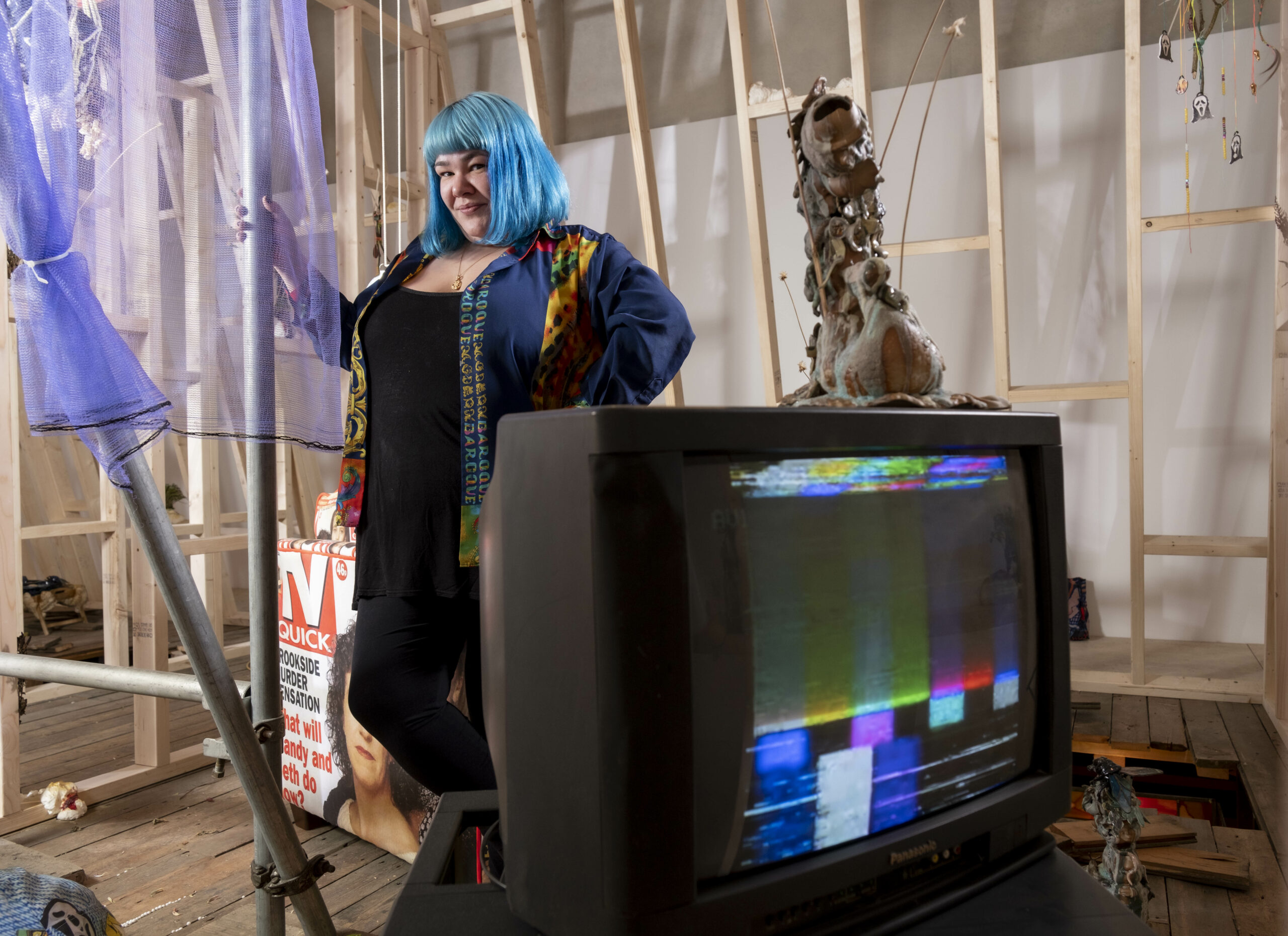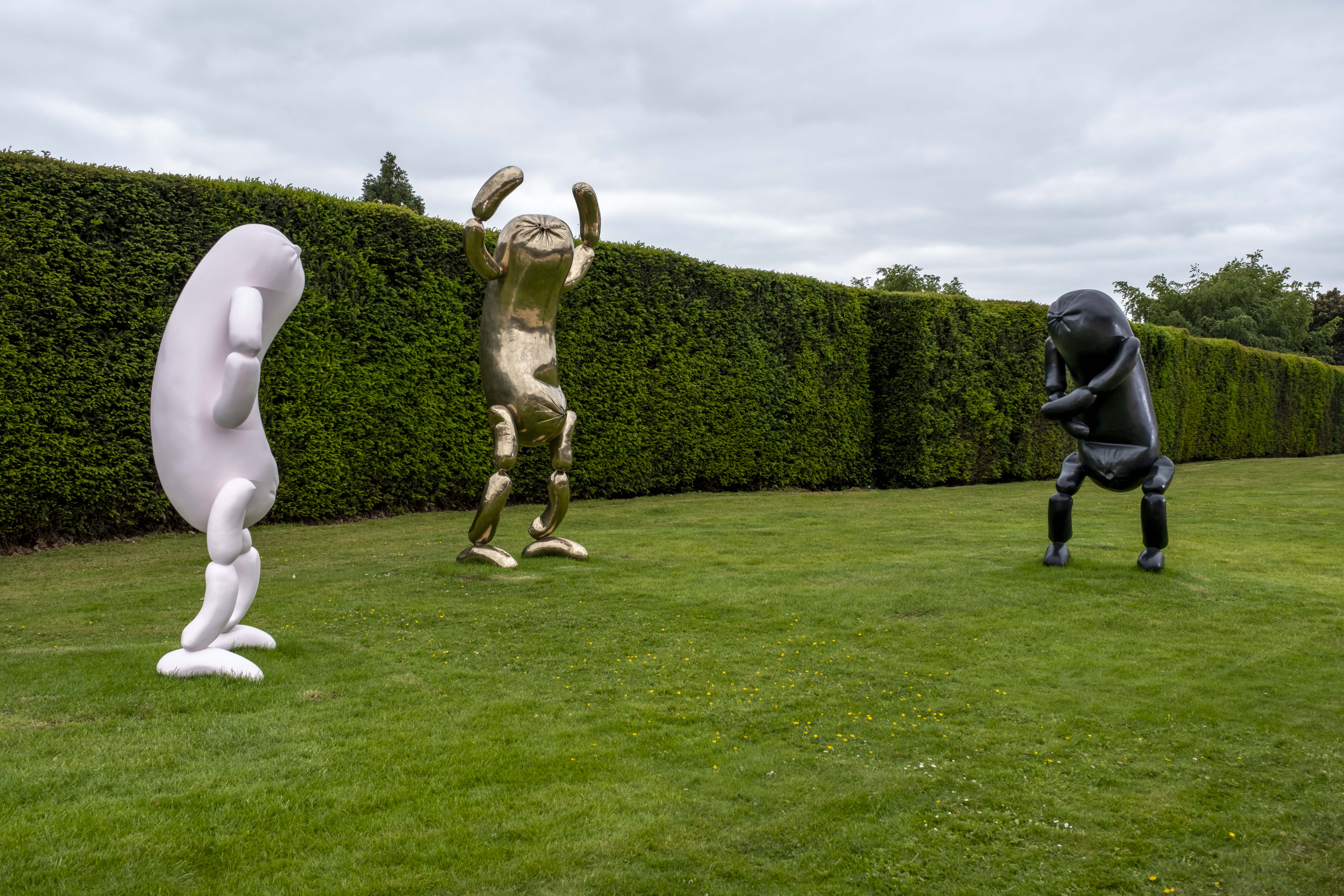Review: Trap of the Truth and Where The Bodies Are Buried
Yorkshire Sculpture Park exhibits work by Erwin Wurm and Lindsey Mendick
Until 28 April 2024, Yorkshire Sculpture Park is home to Trap of the Truth, the first UK exhibition of the work of renowned Austrian artist Erwin Wurm. Comprising over 100 sculptures, paintings, photographs, videos and drawings displayed in galleries and around Bretton Estate, the works span 30 years of Wurm’s career, some exhibited for the first time.
Wurm’s work focuses on the transformation of everyday objects. “I discovered that everything that exists in this world has potential and can be used to make works of art,” he said. “It doesn’t matter whether it’s a car, a table, or a pen. At some point, I realised that my topic is our world and time, always expressed visually in terms of sculptural language.”
These objects feature in several of the works on display. “The German Couch” is an aluminium model of a crushed car, inviting contemplation on the sedentary nature of modern life and the fragile essence of psychoanalysis. “Renault 25”, meanwhile, features a car rebuilt at a slant, reproducing the suggestion of speed associated with comic book illustrations.
Another recurring subject is popular Austrian foods, including gherkins and sausages. Wurm imbues these objects with significance, both defying the conventions of his medium by raising affordable sustenance to the level of art and, by emphasising their phallic forms, offering playful commentary on the elevation of masculinity in European culture.
Wurm is keenly interested in philosophy, drawing on René Descartes’ infamous interpretation of reality – “I think, therefore I am” – for the title of the exhibition.
“Identity, the concept of identity, and the preoccupation with it comes up again and again in my work,” he says. “How do I see myself? Is what I see the same as how others see me? It is about projections, conceptions, precepts, and all those things.”
The installation of many of Wurm’s largest works in the park’s landscape emphasise this preoccupation with the subjectivity of experience.
Three of the first outdoor sculptures visitors encounter are a selection of bronze sausage sculptures. The largest, titled “Giant Big, Me Ideal”, is polished and raises its arms above its head in an attitude of celebration. In bright light, it appears triumphant, but dulled by cloud cover, it adopts a more pathetic resonance. Meaning, Wurm reminds us, is always conditional.
Inside, Gallery Two houses Wurm’s One Minute Sculptures, with which he rose to prominence in the 1990s. The installation invites visitors to interact with a series of objects for one minute.
The gallery walls offer guiding questions and suggestions: “How quickly can you turn yourself into a sculpture? Think about how objects can have personalities. Imagine you were an everyday object. What object would you be? What conversation would you have with a cucumber, a suitcase, a pair of trousers or a caravan just back from its holiday?”
These prompts embody Anne Allison’s theorisation of commodity animism, whereby animism – the Shinto belief that natural objects are imbued with a conscious spiritual life – is combined with commodity fetishism. The result is the personification of purchasable products.
Positioning commodities as a cure for loneliness, “commodity animism cunningly suggests that the real problem is people – their lack of care for each other, their adherence to regressive social structures, and their insatiable desire to consume,” explains researcher Leonie Rowland.
But Wurm’s work is deeply humane, inviting the public to actively interpret and participate in the art on display. While often political, it is never didactic, instead emphasising the role that we all have to play in building the world that we share.

Also on display in The Weston Gallery until 3 September 2023 is Lindsey Mendick’s first solo exhibition, Where The Bodies Are Buried – an installation inspired by a plotline in soap opera Brookside (1982-2003) in which abusive husband and father Trevor Jordache was murdered by his wife, who, with the assistance of their daughter, buried his body under their patio.
Mendick’s work explores the overlap of Gothic storytelling, popular television and the unconscious.
Such connections are embedded in the cultural landscape: as scholar Fred Botting remarks in Gothic Romanced: Consumption, Gender and Technology in Contemporary Fictions (2008), “Gothic romances manifest a descent into anxiety and nightmare.”
Meanwhile, in Haunted Media (2000), Jeffrey Sconce argues that, as “sound and image without material substance, the electronically mediated worlds of telecommunications often evoke the supernatural by creating virtual beings that appear to have no physical form. By bringing this spectral world into the home, the TV set in particular can take on the appearance of a haunted apparatus.”
These associations even influence the manifestation of symptoms of mental illness – the NHS page on schizophrenia notes that hallucinated “voices may come from different places or 1 place, such as the television.”
The installation includes numerous working televisions, positioned at the centre of rooms that depict the unearthing of decomposing bodies via a range of media, from clay to stained glass. The rooms are decorated with 1990s horror iconography, from the “Ghostface” mask from Scream (1996) to the talisman from The Blair Witch Project (1999).
Its emphasis on communal viewership before the days of streaming – the screens all display the same image simultaneously, the sound emerging from one central source – also draws on a history of television horror, from infamous 1992 mockumentary Ghostwatch to “Dead Line”, a 2018 episode of Inside No. 9 by Bretton Hall alumni Reece Shearsmith and Steve Pemberton.
The work is influenced by Mendick’s diagnosis of “Pure Obsessive Thought Disorder, where you have horrible, intrusive thoughts that are like soap opera storylines.”
As soap operas increasingly take inspiration from genuine atrocities – a 2020 Coronation Street plotline, for instance, drew on a house fire in Salford in which four children died – Where The Bodies Are Buried reminds visitors that television’s capacity to comment on the world we live in can be as damaging as it can be informative.
For more information, visit ysp.org.uk.
Images courtesy of Jonty Wilde, YSP and the artists

Leave a reply
Your email address will not be published.